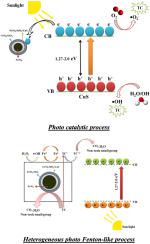Environmental Technology & Innovation ( IF 7.1 ) Pub Date : 2020-07-23 , DOI: 10.1016/j.eti.2020.101035 Negin Nasseh , Behnam Barikbin , Lobat Taghavi

|
In this study, the FeNi3/SiO2/CuS was initially synthesized and characterized using XRD, FTIR, DRS, BET, EDX, VSM, TEM, FESEM and TGA. Then, its efficacy was investigated in the tetracycline photocatalytic degradation process under simulated solar light. The effect of different parameters such as initial tetracycline concentration, catalyst dose, H2O2 concentration, contact time and pH had also been investigated. The maximum degradation efficiency for the photocatalytic degradation phase and photocatalytic heterogeneous Fenton-like phase was obtained at pH = 9 and pH = 5, respectively. The kinetic model of the photocatalytic degradation processes was pseudo-first-order (R.9). Adding hydrogen peroxide to 200 mL at pH = 5 and 0.005 g/L of nanocomposite resulted in the complete removal of tetracycline used in this study at 200 min. The results of the optical catalyst experiments showed that the newly synthesized nanocomposite in this study had the ability to be recycled. Additionally, the degradation pathway of tetracycline in the photocatalytic heterogeneous Fenton-like process manifested the breakdown of the cyclic compound and the simplification of pollutants into linear compounds and finally turned into water and carbon dioxide. Due to the high efficiency of synthesized nanocatalyst in tetracycline degradation by photocatalytic processes, it can be used as an appropriate catalyst for the degradation of resistant organic pollutants.
中文翻译:

FeNi 3 / SiO 2 / CuS磁性纳米复合材料在模拟太阳辐射下光催化降解盐酸四环素的效率,稳定性,动力学和途径研究
在这项研究中,最初使用XRD,FTIR,DRS,BET,EDX,VSM,TEM,FESEM和TGA对FeNi 3 / SiO 2 / CuS进行了合成和表征。然后,在模拟太阳光下,在四环素光催化降解过程中研究了其功效。还研究了不同参数的影响,例如初始四环素浓度,催化剂剂量,H 2 O 2浓度,接触时间和pH。分别在pH = 9和pH = 5时获得了光催化降解相和光催化非均相类Fenton相的最大降解效率。光催化降解过程的动力学模型是拟一阶(R.9)。将过氧化氢添加到pH = 5的200 mL和0.005 g / L的纳米复合材料中,可在200分钟时完全去除本研究中使用的四环素。光学催化剂实验的结果表明,本研究中新合成的纳米复合材料具有回收利用的能力。此外,四环素在光催化非均相Fenton样过程中的降解途径表现出环状化合物的分解和污染物向线性化合物的简化,最后转化为水和二氧化碳。由于合成的纳米催化剂在通过光催化方法降解四环素方面具有很高的效率,因此可以用作降解抗性有机污染物的合适催化剂。



























 京公网安备 11010802027423号
京公网安备 11010802027423号